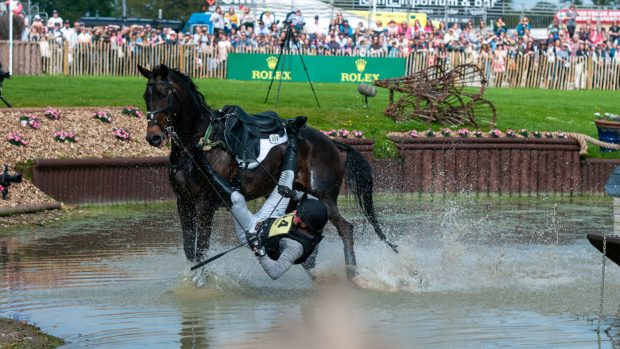Cross-country falls are more likely to occur at four-star and championship events, and to involve less experienced riders, according to recent statistics.
An eventing audit report was undertaken by Charles Barnett, formerly of Aintree and Ascot racecourses, and findings were presented at the FEI general assembly last week (13 November).
The data analysed was from 1,180 falls from 76,638 cross-country starts between July 2010 and December 2014.
The information was taken from horse registrations, rider registrations, technical delegates and fence judges.
“The idea was to track trends and to make suggestions about gathering data,” said Charles.
“There is no single, easy fix to prevent falls. There are a number of factors that can help reduce falls and we will make some recommendations [see below].
“Eventing is a risk sport. We will never be able to eradicate accidents, so we must have a robust plan to deal with the view from the public if they do occur.”
The number of falls is greater at a higher level, and they generally feature less experience riders.
| Related articles |
“Better riders are half as likely to fall as non-categorised riders,” said Charles. “Are we allowing riders who are not proficient enough to take part in three- and four-star events?” he asked.
“You are 3.5% more likely to see a fall at four-star or championships than at one-star. Is it because the competition tougher at championships so riders go to the limit? Or is it the effect of riding on a team?”
‘Surprise’ of frangible result
Types of fences were also discussed — with open corners causing fewer falls than closed, while falls were greater when the obstacle involved water. Downhill jumps were also problematic.
However, footing was one area that was not looked at.
Analysis also showed that there was an increased risk of a fall at fences with frangible pins.
“Frangibles were designed to reduce falls, so the fact they threw up more was surprising, but this needs looking into further. It seems odd to us that breakable fences had more falls,” said Charles.
British Eventing (BE)’s Jonathan Clissold told H&H: “Of the 105 falls at frangible elements, 4% were somersault falls.
“This is considerably fewer than the 11% that occurred at non-frangible fences, which suggests that frangible fences are providing some safety benefit to riders.
“However, due to the small sample size of falls at frangible elements, caution should be taken when interpreting this result.”
New Zealand eventer Bruce Haskell added: “If there’s been a fall but the frangible prevented rotation and saved someone’s life then it’s done its job.”
Putting action in place
Eventing committee chair and course-designer Giuseppe Della Chiesa said it is “important to have an outside view”.
“Many of the conclusions are not surprising, but confirm the commitment to limiting the risk. Many suggestions we are already implementing and many more we will take on board for the future,” he added.
However, Bruce Haskell warned that you need to be “very careful” when interpreting statistics.
“I’m concerned it doesn’t take into account lesser nations,” he said. “However, having concrete results will make course-designers more aware and should make the sport safer — if it impacts how they design courses and, in turn, how courses are tackled by riders.”
Charles Barnett added that more analysis was to be undertaken.
Recommendations from Charles Barnett
- There is a strong argument to restrict the top events to the best riders
- Standardise entry requirements around the world to make analysis easier
- Consider having another category of rider, or a rider licence to have greater control of competition and testing






